General
UNIT 12: Human Sensory Organs
Organs which help us to see, hear, smell, taste and feel are called
 .
.The organs which help us to know the world around us are eyes, ears, nose, tongue and skin.
These are our sensory organs.


1. Research on the functional mechanism of all sensory organs
from library or search engines like Google or Yahoo.
2. Make a report on it and present to the class.
Sensory organs are connected to the brain through nerves. T
hey work as follows:
Each sensory organ receives stimuli such as touch, heat, cold
and pressure from the environment.
The sensory organ transmits this information to the brain through sensory nerves.
The brain interprets this information and gives feedback to the sensory organ through motor nerves.
The sensory organ transmits this information to the brain through sensory nerves.
The brain interprets this information and gives feedback to the sensory organ through motor nerves.






1. Run around your school playground twice.
2. Now observe your skin. What is formed on your body?
The substance you see on your body is sweat. Others can say you are sweating.
The main functions of the skin include:
1. It allows us to have a sense of touch.
2. It protects our body from harmful germs.
3. It regulates our body temperature.
4. It helps us to release waste products as sweat.

Skin has the following properties:
1. Different people have different skin colours.
Some people have light skins.
and Others have dark skins.
2. Skin may be oily and dry.

A clean skin cannot be attacked by diseases.
So it is important to keep our skin clean.
To keep the skin clean:
1. Take a bath every day.
2. Use good soap while bathing.
3. Rub and wash every part of the body.

4. After taking bath, wipe your body with a clean towel.
5. Wear clean and ironed clothes.
6. Always eat healthy food and drink plenty of water.
7. Always protect your skin from injuries.


The following are some common skin diseases:

Ringworm usually causes itching. It begins as a small red area.
This grows larger. It appears as red, scaly ring.
There may be one or several patches.
Ringworm can be easily cured with medicine.
The affected person should use his/ her own comb, soap and towel.

Eczema is characterised by itching and inflammation.
The inflamed skin may be dry, swollen and crusty.
It may even ooze fluids.
Eczema can be prevented if we wash our skin carefully with good soap.
Doctors prescribe ointments and creams for early relief.

Scabies causes intense itching. It may affect any part of the body from neck down.
It frequently involves the skin between the fingers, under the arms,
and on the wrists. It is caused by mites.
Scabies spreads through skin contact.
Doctors treat the disease with creams and lotions that kill the mites.
Scabies can easily spread from one family member to another.

Leprosy is an infectious disease.
Its main symptoms include white or reddish patches on skin,
loss of feeling in skin and thickened nerves.
The fingers and toes may curl inward.
Early detection and treatment can control leprosy.









You will feel uneasy. This is because the nose helps us to breathe. Nose also helps us to smell.

The following are some common nose diseases:

The common cold is a viral infectious disease. A person with common cold feels a runny nose. He/She sneezes from time to time. It causes headache and weakness.

The causes of common cold include:
1. Transmission of cold viruses through air-borne droplets
2. Cold weather condition such as rain or winter
3. Poor immune functions
4. Insufficient sleep and malnutrition.

It is an infection of the sinuses near the nose. When a person suffers from sinusitis, his/her nose is blocked. He/She does not breathe well. He/She has headache and facial discomfort.

The causes of sinusitis include:
1. Microorganisms such as virus, bacterium or fungus
2. Abnormalities in the structure of the nose
3. It can be caused by allergy and irritation of sinuses.

The following measures should be taken to prevent nose diseases:
1. Avoid close contact with the people who are sick.
2. Wear face mask when you are in crowds.
3. Cover your mouth and nose while others are sneezing or coughing.
4. Wash your hands with a soap. It reduces the spread of viruses.

Nose injuries often occur during play, sports and accidents. Some of the nose injuries include:

A broken nose is a fracture in a bone in the nose.
It commonly occurs with face injuries.
Some causes of broken nose include:
falling down and motor vehicle accidents.
A person suffering from broken nose has the following symptoms :
1. Nose pain.
2. Swelling of the nose.
3. Bruising around the nose or eyes.
4. A runny nose or a nosebleed.
5. Blocked nasal passages.
In case of broken nose:
1. If you have nose bleeding, sit upright and breathe through the mouth.
2. To reduce swelling, apply an icepack on the nose
. 3. In severe cases, consult a doctor.

Nosebleed is the flow of blood from one or both nostrils.
It is caused due to minor injury to the nose.
If you have nosebleed:
1. Sit upright and breathe through the mouth
2. Keep an icepack on the nose to stop bleeding
3. In case of severe bleeding, consult a doctor.





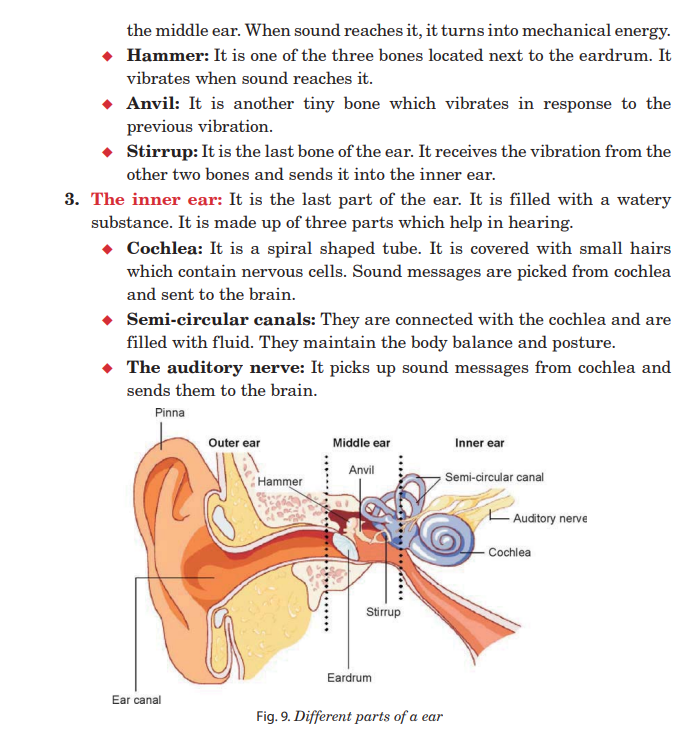



1. Discuss the following questions with your parents.
Why do we clean our ears regularly?
What materials are suitable for cleaning ears?
Why is it unsafe to clean ears with sharp or hard objects?
2. Make a report on it and present to the class.
Regular cleaning of ears prevents some ear problems.
Therefore, these should be cleaned properly.
1. Do not clean your ears with toothpicks, matchsticks or any sharp objects.
It can injure the delicate part of the ears.
2. Use cotton buds to clean your ears.
3. Keep you away from loud sound.
Loud sound can damage the ears.
4. Do not push things like beads and small stones into your ears.

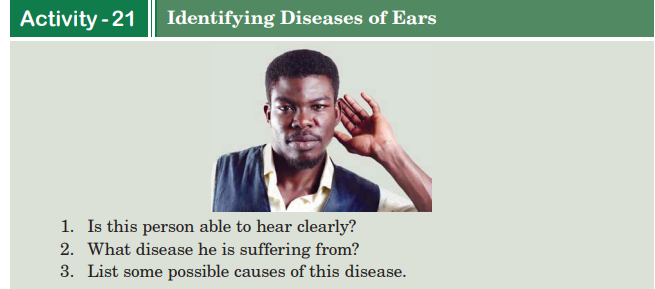
He is suffering from ear disease. Some common ear diseases are: hearing loss and deafness.

Hearing loss is the reduced ability to hear sound.
It occurs when sound waves do not reach the brain.
Basically, there are two types of hearing loss.

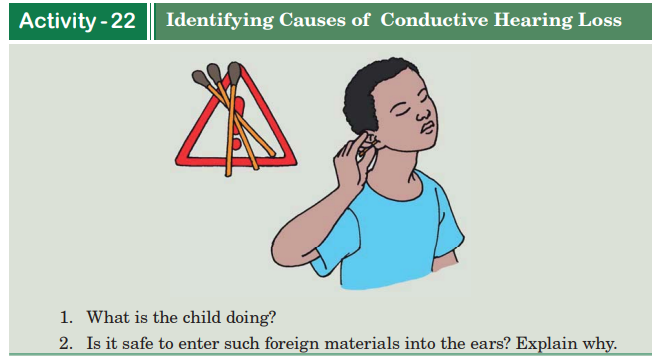
The child is cleaning his ears using a matchstick.
It is unsafe to enter such foreign materials into the ears.
It may cause problems with ear canal, ear drums and middle ear.
It may lead to conductive hearing loss. Some other
 of conductive hearing loss are:
of conductive hearing loss are: 1. Infection in the ear canal.
2. Tumour in the ear canal.
3. Much ear wax in the ear canal.
This disease is temporary.
It can be cured by removing ear wax and other
foreign materials from the ears.

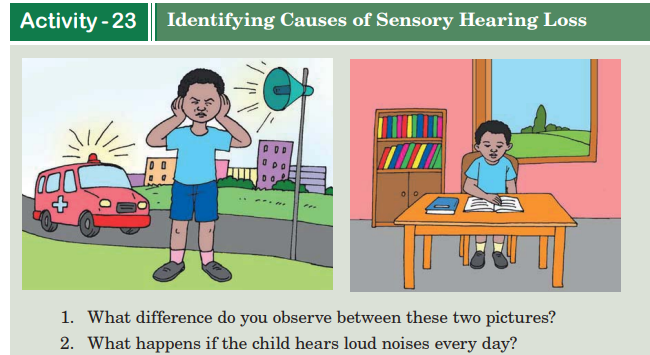
In the first picture,
the child is hearing loud noise coming from vehicles and loud speakers.
If he hears such loud noise for a long time,
he will suffer from sensory hearing loss.
Sensory hearing loss is due to the problem in the inner ear.
A person with such disease cannot understand what he/she is hearing.
This disease is nerve-related.
Some other
 of sensory hearing loss are:
of sensory hearing loss are:1. Old age
2. Injury to the ear canal
3. Ear infection.
This disease can be cured by:
1. Treatment of ear infection
2. Avoiding travel in the vehicles which produce loud sound
3. Treatment of infection in the ear canal.

Deafness is the complete inability to hear sound.
It is caused by damage to the inner ear.
Basically, there are three types of hearing loss. These are:

It is the condition in which a person is unable to hear properly.
It can be
 by the following factors:
by the following factors:1. Intrusion of foreign materials in the ear
2. Much ear wax in the ear canal
3. Holes in the ear drum.
This disease is temporary.
It can be cured by removing ear wax and other foreign materials from the ears.

It is the condition in which a person is completely unable to hear.
In some cases, deafness is inherited from parents to their child.
This type of deafness is permanent and cannot be cured.

It is due to the problem in the nervous system.
A person with such a disease cannot understand what he/she is hearing.
It can be
 by the following factors:
by the following factors:1. Disease of the blood vessels
2. Loud noises or sounds
3. Tumour in the ear canal
4. Use of certain medicines (drugs) that are harmful to hearing.
This disease can be cured by:
1. Treating the diseases of the blood vessels.
2. Avoiding working around loud noises every day.
3. Removing tumour from the ear canal by surgery.


1. Choose a partner and face each other.
2. Look into the eyes of your partner closely.
3. Observe and describe the parts you see.
You can see a dark round part in the eye.
There is a darker spot at the middle of it.
It is the hole through which light enters into the eye.

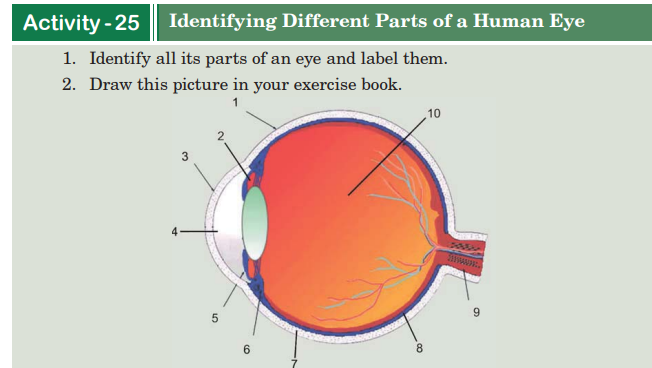

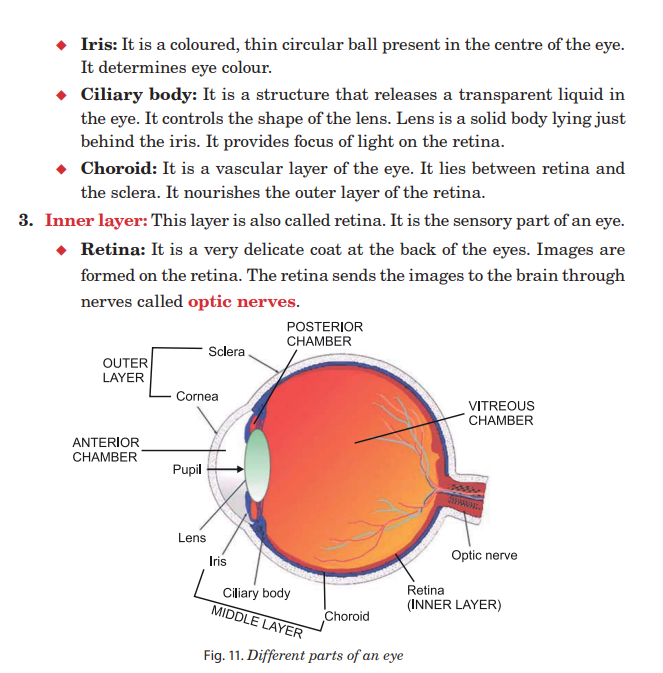


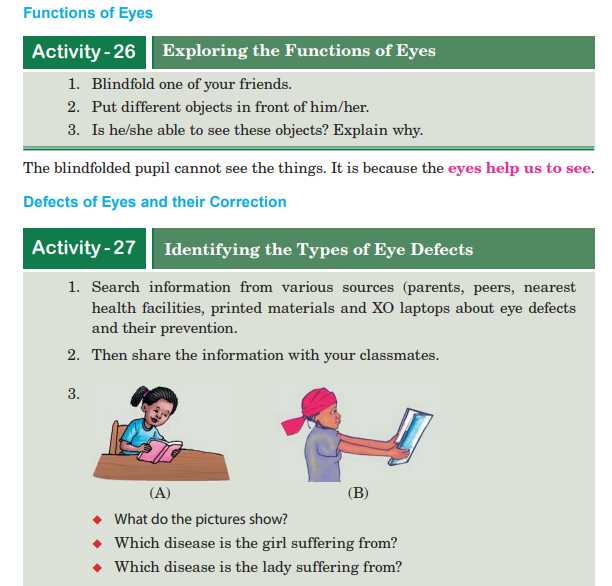
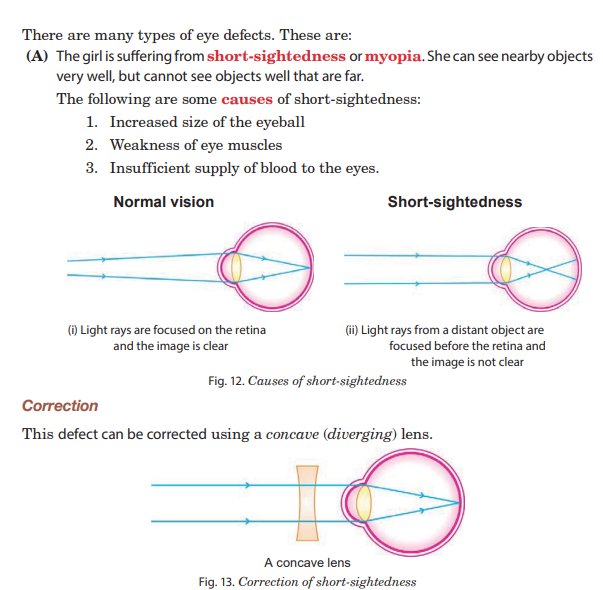



Presbyopia is a progressive form of long-sightedness.
It affects most people by their early 60s.
Most people find that the near point gradually diminishes.

It arises due to the gradual weakening of the eye muscles.
Simple reading eyeglasses with convex lenses correct most cases of presbyopia.
Sometimes, a person may suffer from both myopia and hypermetropia.
Such people often require be focal lenses .
In the bi-focal lens, the upper portion of the bi-focal lens is a concave lens,
used for distant vision.
The lower part of the bi-focal lens is a convex lens,
used for reading purposes.


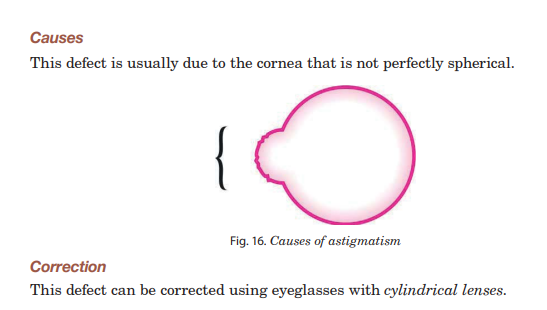
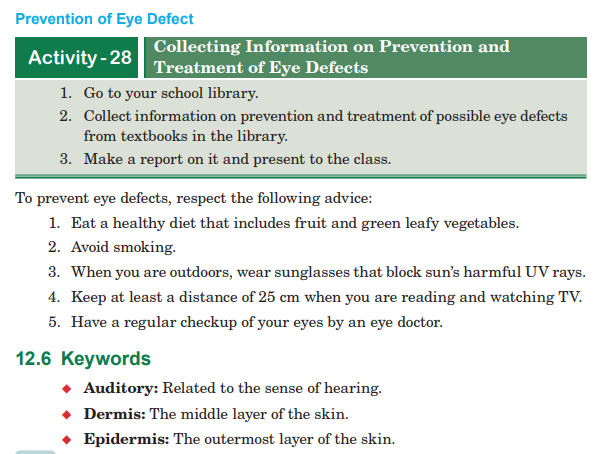
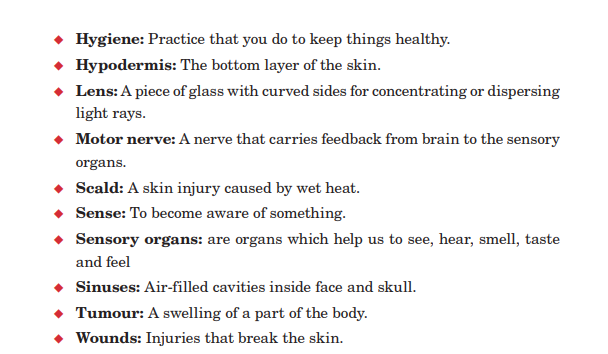



Do these review exercises in your exercise book.

1. Organs which help us to see, hear, smell, taste and feel are called ............. .
(a) breathing organs (b) sensory organs
(c) reproductive organs (d) none of these
2. ………… is the sensory organ for touch and feel.
(a) Ear (b) Eye
(c) Skin (d) Nose
3. ………… is the sensory organ of sight.
(a) Ear (b) Eye
(c) Skin (d) Nose
4. ………… is the sensory organ of taste.
(a) Ear (b) Eye
(c) Skin (d) Tongue
5. ………… is the sensory organ of hearing.
(a) Ear (b) Eye
(c) Skin (d) Nose
6. ………… is the sensory organ for smell.
(a) Ear (b) Eye
(c) skin (d) Nose
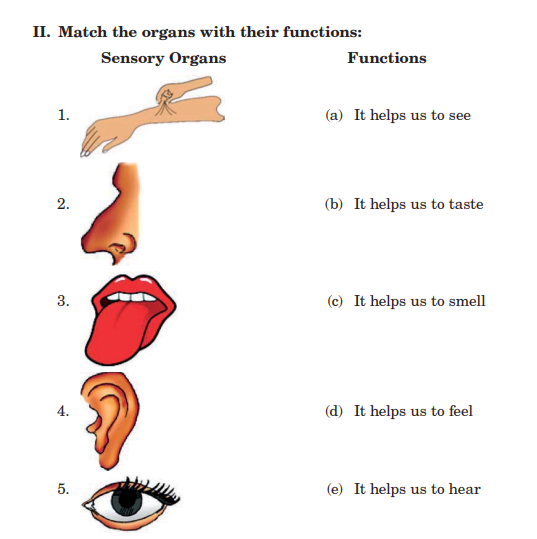

1. Sensory organs are connected to brain through nerves.
2. Tongue enables us to balance our body.
3. The inner ear has three tiny bones.
4. Retina is the outer layer of the eye.
5. Short-sightedness can be corrected using a convex lens.

1. Explain the mechanism of sensory organs.
2. What are the specific functions of skin?
3. List any two properties of skin.
4. Name any three skin diseases.
5. What are bruises?
6. What are the specific functions of tongue?
7. How can you take care of your tongue?
8. List some tongue disorders and their causes.
9. What are the specific functions of nose?
10. Explain how to maintain the hygiene of tongue.
11. List two nose diseases, their causes and preventions.
12. State the functions of ears.
13. Mention some ear diseases and their causes.
14. List some eye defects and their corrections.
15. How can you prevent eye defects?

Across
5. Organs which help us to see, hear, smell, taste and feel.
Down
1. It is the sensory organ for taste.
2. It is the sensory organ for smell.
3. These are the sensory organs for sight.
4. These are the sensory organs for hearing.
5. It is the outermost covering of our boy.
